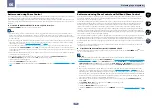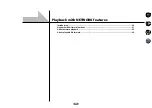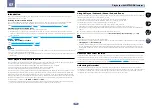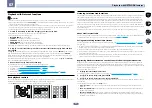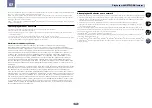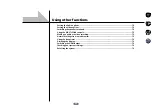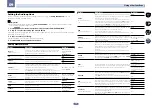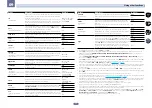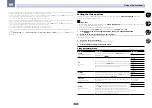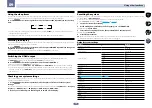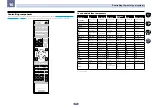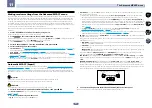
70
09
Using other functions
Setting the Audio options
There are a number of additional sound settings you can make using the
AUDIO PARAMETER
menu. The
defaults, if not stated, are listed in bold.
Important
!
Note that if a setting doesn’t appear in the
AUDIO PARAMETER
menu, it is unavailable due to the current
source, settings and status of the receiver.
1 Press
to the receiver operation mode, then press AUDIO PARAMETER.
2 Use
i
/
j
to select the setting you want to adjust.
Depending on the current status/mode of the receiver, certain options may not be able to be selected. Check the
table below for notes on this.
3 Use
k
/
l
to set as necessary.
See the table below for the options available for each setting.
4 Press RETURN to confirm and exit the menu.
Audio parameter menu
Setting
What it does
Option(s)
MCACC
(MCACC preset)
Selects your favorite MCACC preset memory when multiple preset
memories are saved. When an MCACC preset memory has been
renamed, the given name is displayed.
c
M1. MEMORY 1 to
M6. MEMORY 6
d
Default:
M1. MEMORY 1
EQ
(Acoustic Calibration EQ)
Switches on/off the effects of EQ Pro.
ON
OFF
S-WAVE
(Standing Wave)
Switches on/off the effects of Standing Wave Control.
ON
OFF
PHASE C+
(Phase Control Plus)
For discs created with standards other than Phase Control, the LFE
channel is delayed upon recording in the first place. This function
corrects for phase shifting on such discs.
This function is especially effective when playing music.
When
AUTO
is selected, the LFE channel’s delay is measured auto-
matically and the disc is played with the optimum correction.
c
AUTO/0 to 16 (ms)
d
Default:
AUTO
DELAY
(Sound Delay)
Some monitors have a slight delay when showing video, so the
soundtrack will be slightly out of sync with the picture. By adding a
bit of delay, you can adjust the sound to match the presentation of
the video.
c
0.0 to 10.0 (frames)
d
1 second = 30 frames
(NTSC)
Default:
0.0
TONE
(Tone Control)
Applies the treble and bass tone controls to a source, or bypasses
them completely.
BYPASS
ON
BASS
<a>
Adjusts the amount of bass.
c
–6 to +6 (dB)
d
Default:
0
(dB)
TREBLE
<a>
Adjusts the amount of treble.
c
–6 to +6 (dB)
d
Default:
0
(dB)
Setting
What it does
Option(s)
S.RTRV
(Auto Sound Retriever)
<b>
With the Auto Sound Retriever function, DSP processing is used to
compensate for the loss of audio data upon compression, improving
the sound’s sense of density and modulation.
Also, when a player supporting the Sound Retriever Link function is
connected to the receiver by HDMI, by setting this to
ON
, the bitrate
information of the compressed audio file being played on the player
is acquired using the
Control
with HDMI function, and the sound is
optimized based on this information (Sound Retriever Link).
OFF
ON
DNR
(Digital Noise Reduction)
May improve the quality of sound in a noisy source (for example, video
tape with lots of background noise) when switched on.
This only has an effect with 2-channel signal inputs.
This mode is effective for contents with a sampling frequency of 48
kHz or less.
OFF
ON
DIALOG E
(Dialog Enhancement)
<c>
Localizes dialog in the center channel to make it stand out from other
background sounds in a TV or movie soundtrack. By moving from UP1
through UP2 and UP3 up to UP4, you can make the sound source
seem to relocate upwards.
c
OFF/FLAT/UP1/UP2/
UP3/UP4
d
Default:
OFF
Hi-bit32
Creates a wider dynamic range with digital sources like CDs, DVDs or
BDs. 16-, 20- and 24-bit PCM as well as compressed audio is requan-
tized to 32 bits, and the high frequency component is interpolated
upon data processing to enable smoother, more subtle musical
expression.
This mode is effective for contents with a sampling frequency of 48
kHz or less.
ON
OFF
DFILTER
(Digital Filter)
Switches the AUDIO DAC (Digital Audio Converter) digital filter type.
One of three settings can be selected:
SLOW
(soft and warm),
SHARP
(solid and tight) and
SHORT
(quick and forward).
SLOW
(Hi-Sampling)
SHARP
SHORT
DUAL
(Dual Mono)
Specifies how dual mono encoded Dolby Digital soundtracks should
be played. Dual mono is not widely used, but is sometimes necessary
when two languages need to be sent to separate channels.
CH1
– Channel 1 is
heard only
CH2 – Channel 2 is
heard only
CH1 CH2 – Both chan-
nels heard from front
speakers
Fixed PCM
This is useful if you find there is a slight delay before
OFF
recognizes
the PCM signal on a CD, for instance.
When
ON
is selected, noise may be output during playback of non-
PCM sources. Please select another input signal if this is a problem.
OFF
ON
DRC
(Dynamic Range Control)
<d>
Adjusts the level of dynamic range for movie soundtracks optimized
for Dolby Digital, DTS, Dolby Digital Plus, Dolby TrueHD, DTS-HD and
DTS-HD Master Audio (you may need to use this feature when listen-
ing to surround sound at low volumes).
AUTO
MAX
MID
OFF
Loud Mgmt
(Loudness Management)
Adjusts the level of dynamic range for movie soundtracks optimized
for Dolby TrueHD (you may need to use this feature when listening to
surround sound at low volumes).
This can only be set when
DRC
is set to
OFF
and the input signal is a
Dolby TrueHD signal.
ON
OFF



